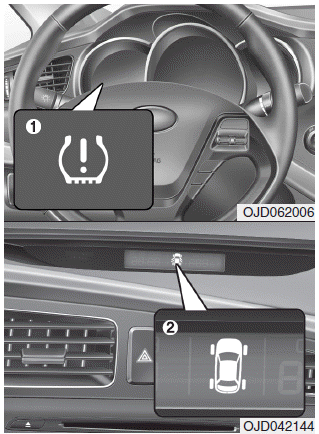Kia Cee'd: What to do in an emergency / Tire Pressure Monitoring System (TPMS)

(1) Low tire pressure telltale / TPMS malfunction indicator
(2) Low tire pressure position telltale (Shown on the instrument panel display)
Each tire, including the spare (if provided), should be checked monthly when cold and inflated to the inflation pressure recommended by the vehicle manufacturer on the vehicle placard or tire inflation pressure label. (If your vehicle has tires of a different size than the size indicated on the vehicle placard or tire inflation pressure label, you should determine the proper tire inflation pressure for those tires.)
As an added safety feature, your vehicle has been equipped with a tire pressure monitoring system (TPMS) that illuminates a low tire pressure telltale when one or more of your tires is significantly under-inflated. Accordingly, when the low tire pressure telltale illuminates, you should stop and check your tires as soon as possible, and inflate them to the proper pressure. Driving on a significantly under-inflated tire causes the tire to overheat and can lead to tire failure. Under-inflation also reduces fuel efficiency and tire tread life, and may affect the vehicle’s handling and stopping ability.
Please note that the TPMS is not a substitute for proper tire maintenance, and it is the driver’s responsibility to maintain correct tire pressure, even if under-inflation has not reached the level to trigger illumination of the TPMS low tire pressure telltale.
Your vehicle has also been equipped with a TPMS malfunction indicator to indicate when the system is not operating properly. The TPMS malfunction indicator is combined with the low tire pressure telltale. When the system detects a malfunction, the telltale will flash for approximately 1 minute and then remain continuously illuminated. This sequence will continue upon subsequent vehicle start-ups as long as the malfunction exists. When the TPMS malfunction indicator remains illuminated after blinking for approximately 1 minute, the system may not be able to detect or signal low tire pressure as intended.
TPMS malfunctions may occur for a variety of reasons, including the installation of replacement or alternate tires or wheels on the vehicle that prevent the TPMS from functioning properly. Always check the TPMS malfunction telltale after replacing one or more tires or wheels on your vehicle to ensure that the replacement or alternate tires and wheels allow the TPMS to continue to function properly.
✽ NOTICE
If any of the below happens, we recommend that the system be checked by an authorized Kia dealer.
1.The low tire pressure telltale/
TPMS malfunction indicator do
not illuminate for 3 seconds when
the ignition switch is turned to the
ON position or engine is running.
2.The TPMS malfunction indicator
remains illuminated after blinking
for approximately 1 minute.
3.The Low tire pressure position
telltale remains illuminated.
- Low tire pressure telltale, Low tire pressure position telltale
- Tire Pressure Monitoring System (TPMS) malfunction indicator
- Changing a tire with TPMS
 Notes on the safe use of the Tire
Mobility Kit
Notes on the safe use of the Tire
Mobility Kit
Park your car at the side of the
road so that you can work with the
Tire Mobility Kit away from moving
traffic.
To be sure your vehicle will not
move, even when you're on fairly
le ...
 Low tire pressure telltale, Low tire pressure position
telltale
Low tire pressure telltale, Low tire pressure position
telltale
Low tire pressure telltale:
Low tire pressure position
telltale:
When the tire pressure monitoring
system warning indicators are illuminated,
one or more of your tires is
significantly ...
Other information:
Kia Cee'd JD Service Manual: Luggage Side Trim Repair procedures
Replacement
[5Door]
•
Put on gloves to protect your hands.
•
...
Kia Cee'd JD Service Manual: Drive Belt Tensioner Repair procedures
Removal and Installation
1.
Remove the drive belt.
(Refer to Timing System - "Dreve Belt")
2.
Remove the alternator.
(Refer to Engine Electrical System - "Alternator")
3.
...
